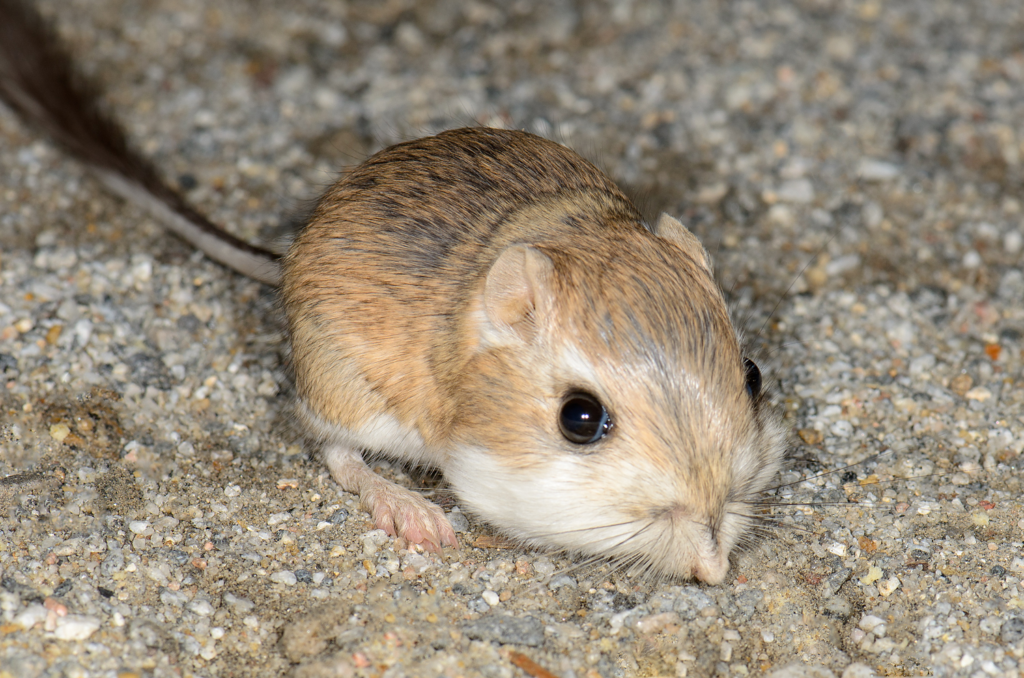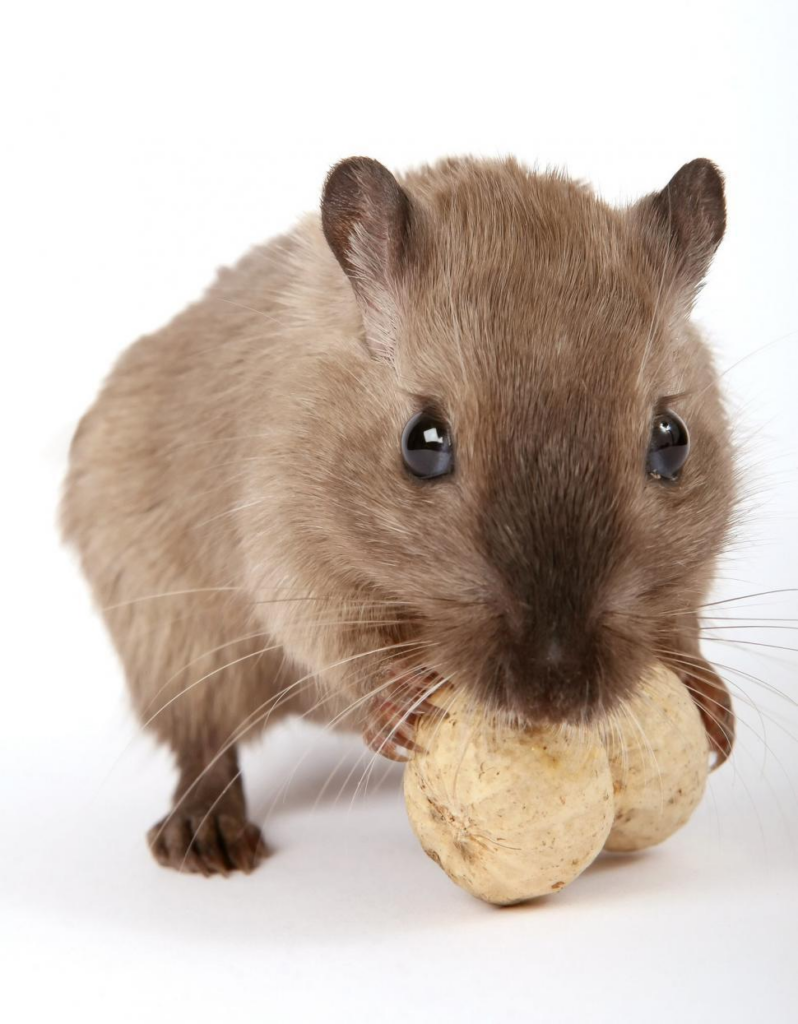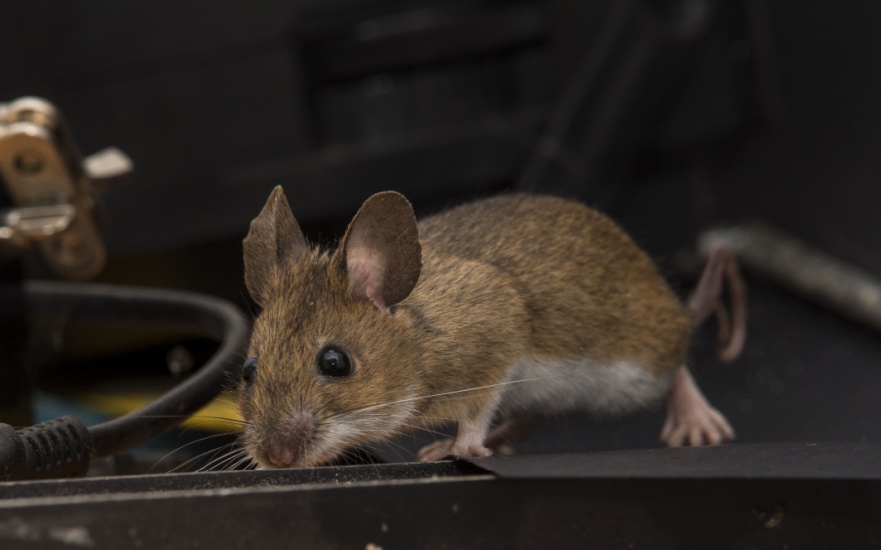Seeing mice in your house is scary. Mice like homes because of food and shelter. Our homes are perfect for mice, with lots of food and cozy spots.
Knowing why you have mice is key to fixing the problem. Mice get into homes through small openings. They can ruin food, wires, and insulation. They also spread diseases.
Key Takeaways
- Mice are attracted to food and shelter, making homes an ideal place for them.
- Poor food storage and clutter can contribute to mouse infestations.
- Mice can enter homes through gaps, cracks, and holes in walls and foundations.
- Signs of mice include droppings, gnaw marks, and scurrying sounds.
- Understanding the type of mice (field or house mice) is important for pest control.
Understanding Mouse Infestations in American Homes
Mouse infestations in homes are more than just a nuisance. They can cause a lot of damage and health risks. It’s important to know the common mouse species in American homes, their behavior, and how they reproduce.
Common House Mouse Species in the United States
The most common mouse in American homes is the house mouse (*Mus musculus*). This mouse is very adaptable and can live in many different places.
Some key traits of house mice include:
- They eat a wide variety of foods like grains, fruits, and insects.
- They breed a lot, with females having many litters a year.
- They are most active at night.
Mouse Behavior and Reproduction Cycles
Knowing how mice behave and reproduce is key to controlling them. Mice live in groups and have a social hierarchy.
Things that affect their reproduction include:
- How much food and water they have
- The temperature and humidity
- Presence of predators or other mice
By understanding these, homeowners can better prevent and deal with mouse infestations.

Recognizing the Signs of a Mouse Problem
Seeing signs of mice at home is the first step to solving a big problem. Mice can damage your stuff, make food dirty, and spread sickness. So, spotting the signs early is key.
Visual Evidence: Droppings, Gnaw Marks, and Nests
Visual signs are often the most obvious signs of mice. Look for mouse droppings, gnaw marks, and nests. Mouse droppings are small, dark, and look like pellets.
They show up in places mice like, like walls, pantries, or near food. For more info, check out common signs of rodent infestation.
Gnaw marks on furniture or walls mean mice are there. They gnaw to keep their teeth short. Nests from shredded stuff can hide in spots like behind appliances or in walls.
Auditory Clues: Scratching and Movement Sounds
Scratching or movement sounds, mainly at night, mean mice might be around. These sounds are often in walls, ceilings, or under floors. Mice are most active at night, so hearing these sounds then is a strong sign.
Olfactory Signs: Distinctive Mouse Odors
A bad smell can mean mice are around. It comes from their pee or nesting stuff. This smell is strong in small, poorly ventilated places.
If you smell a musty smell that won’t go away, it might mean mice are there.

Why Do Mice Enter Your Home?
Mice look for shelter and food in our homes as the seasons change. It’s important to know why they do this to stop them.
Seasonal Factors Affecting Mouse Invasions
Mice adapt to seasonal changes. When their outdoor homes are not good, they come inside.
Fall and Winter Migration Patterns
When it gets cold, mice move into homes. They want warmth and food.
- Mice seek insulation and warmth in homes during the colder months.
- They are attracted to easily accessible food sources, such as pantry staples and improperly stored garbage.
- Cluttered homes provide ideal nesting sites for mice.
Spring and Summer Nesting Behaviors
In spring and summer, mice focus on making babies and homes. They invade homes for safe places to raise their young.
- Mice often nest in hidden areas such as behind walls, in attics, or under flooring.
- The presence of moisture and food can attract mice to specific areas within a home.
- Nesting materials like paper, fabric, and insulation are commonly used by mice.
Environmental Changes That Drive Mice Indoors
Changes in the outdoors can also bring mice inside. Things like new landscaping or building can make their outdoor homes bad.
For more info on mouse problems, visit our page on why do I have a mouse problem in my home
Common Entry Points for Mice in Residential Properties
Mice can fit through tiny openings. It’s important to find where they get in. Knowing these spots helps keep your home mouse-free.
Exterior Vulnerabilities
Exterior spots are the first defense against mice. It’s key to check your home’s outside for entry points.
Foundation Cracks and Gaps
Cracks in the foundation or gaps around doors and windows let mice in. Use caulk or steel wool to seal these spots.
Roof and Attic Access Points
Mice can sneak in through the roof or attic. Look for damaged roof tiles and make sure vents are screened.
Utility Line Entrances
Utility lines like electricity, gas, or water can let mice in if not sealed. Check these spots and seal any gaps to stop mice.
Interior Pathways and Hidden Access Routes
After mice get in, they move through your home. Knowing where they go helps find them.
They often go behind appliances, inside walls, and under flooring. Keep these places clean and tidy to keep mice away.

What Attracts Mice to Your Home?
To keep mice away, it’s key to know what draws them. They seek food, shelter, and water. Knowing this helps make your home less inviting to them.
Food Sources That Lure Mice
Mice are drawn to many foods found in homes. These include:
- Pet food left out
- Crumbs and spills not cleaned up
- Unsealed food containers
- Garbage not thrown out often
Keeping your home clean and food sealed is important. Also, throw out garbage regularly.
Nesting Materials and Shelter Opportunities
Mice seek materials for nests and hiding spots. Common items include:
- Paper products like cardboard and paper towels
- Fabric and cloth items
- Insulation materials
Less clutter and organized storage areas help. Sealing holes and gaps also reduces hiding spots for mice.
Water Sources and Moisture Problems
Mice need water to live, and moisture draws them. Common issues include:
- Leaky faucets and pipes
- Poor drainage around the home
- High humidity levels
Fixing leaks and improving drainage helps. Using dehumidifiers also reduces moisture, making your home less appealing to mice.
Health Risks Associated with Mouse Infestations
Mouse infestations in homes are not just a nuisance. They also pose significant health risks to occupants. Mice can carry and transmit various diseases. Their presence can also exacerbate respiratory issues and trigger allergic reactions. Understanding these health risks is key to taking prompt action against mouse infestations.
Diseases Transmitted by Mice
Mice are known carriers of several diseases that can be transmitted to humans. These diseases can be spread through direct contact with mice or their droppings, urine, or saliva.
- Direct contact with contaminated food or water
- Inhaling aerosolized virus particles
- Touching contaminated surfaces and then touching one’s face
Hantavirus and Other Respiratory Diseases
Hantavirus is a serious respiratory disease caused by a virus that mice carry. When mice droppings or urine dry out, they can become airborne and be inhaled, leading to Hantavirus Pulmonary Syndrome (HPS). HPS is a severe and sometimes fatal respiratory disease.
Some key facts about Hantavirus include:
- It’s mainly spread through contact with rodent droppings, urine, or saliva
- Symptoms can include fever, fatigue, and muscle aches, progressing to respiratory failure
- There is no cure for HPS, making prevention critical
Salmonellosis and Food Contamination
Salmonellosis is another disease that mice can transmit, mainly through contaminating food and water sources. Mice can carry Salmonella bacteria in their intestines, and their droppings can contain these bacteria.
- Food poisoning from Salmonella can cause severe diarrhea, fever, and abdominal cramps
- Vulnerable populations, such as the elderly and young children, are at higher risk of severe illness
Allergies and Respiratory Issues
Mice can also trigger allergies and exacerbate respiratory conditions like asthma. Their dander, droppings, and urine can become airborne and be inhaled, causing allergic reactions.
Some common issues include:
- Allergic rhinitis (hay fever) symptoms, such as sneezing and runny nose
- Exacerbation of asthma symptoms, leading to wheezing and shortness of breath
- Skin irritation or dermatitis in some cases
We must take mouse infestations seriously and address them promptly to mitigate these health risks. By understanding the diseases and conditions that mice can cause or exacerbate, we can better protect our homes and health.
DIY Mouse Control Methods That Actually Work
Getting rid of mice is easy with DIY methods. You can trap them, use natural deterrents, and keep your home clean. These steps help you control mouse problems.
Trapping Techniques and Best Practices
Trapping is key in mouse control. You need the right traps and to place them well.
Snap Traps vs. Live Traps
Snap traps kill mice fast. Live traps catch them alive for release outside. Your choice depends on what you prefer and the mouse problem’s size.
- Snap traps are quick and simple.
- Live traps are kinder.
- Think about where you’ll put them and what you’re comfortable with.
Optimal Trap Placement
Put traps where mice are most active. This means along walls and near food. It makes traps more effective.
- Find where mice go and where they live.
- Set traps against walls.
- Use many traps to cover more ground.
Natural Deterrents and Repellents
Peppermint oil, lavender, and cloves can keep mice away. Use them with traps for a strong defense.
Natural deterrents are safe and good for those who don’t want chemicals. They help keep mice out of your home.
Sanitation and Exclusion Strategies
Cleanliness is important in mouse control. Keep your home tidy, store food right, and get rid of standing water. This makes your home less attractive to mice.
Sealing off entry points is also key. This means fixing cracks around doors, windows, and pipes. It stops mice from coming in.
- Keep your home clean and organized.
- Lock food away in mouse-proof containers.
- Look for and fix any holes or gaps.
Using traps, natural repellents, and keeping your home clean and sealed can help you deal with mice. It also stops them from coming back.
When and Why to Consider Professional Mouse Removal
DIY methods work for small mouse problems. But big infestations need a pro. Mice can damage your home and make you sick if not stopped fast.
Signs of a Severe Mouse Infestation
Knowing if you have a big mouse problem is key. Look for these signs:
- Seeing mice during the day
- Many mouse droppings around
- Big gnaw marks on things
- Nests from shredded paper or fabric
Benefits of Professional Pest Control Services
Experts have many advantages for big mouse problems. They can:
- Find where mice get in and hide
- Use cool tools to find mice
- Make a plan that really works
Advanced Detection Methods
Experts use cool tools to find mice. They use:
- Thermal cameras to see hidden mice
- Special tools to find nests and where mice get in
Comprehensive Treatment Approaches
Experts have a detailed plan to get rid of mice. It includes:
- Sealing holes to keep mice out
- Trapping mice in a kind way
- Cleaning and making your home less inviting to mice
Preventing Future Mouse Problems in Your Home
To keep your home mouse-free, you need to prevent them all year. Knowing how mice behave helps a lot. This way, you can lower the chance of mice coming back.
Year-Round Prevention Strategies
Sealing all entry points is key. This means blocking holes around pipes, vents, and doors. Steel wool or caulk works well for this.
Also, keep your home tidy. Store food in sealed containers. And don’t have too much clutter. This makes your home less inviting to mice.
- Seal all cracks and crevices around your home’s foundation and walls.
- Keep your kitchen counters and floors clean and clear of clutter.
- Store food and pet food in rodent-proof containers.

Seasonal Maintenance Tips
Seasons change, and so do mouse control needs. Being proactive and adjusting your methods helps protect your home.
Fall and Winter Preparation
As it gets colder, mice look for warmth. Your home becomes more appealing. To get ready:
- Check your home’s outside for entry points and seal them.
- Clean up yard debris and clutter that mice might like.
- Use humane traps or repellents to help keep mice away.
Spring and Summer Vigilance
In warmer months, mice are more active outside. But they can sneak into your home. To stay alert:
- Look for mouse signs like droppings or gnaw marks on your home.
- Keep your yard clean and free of clutter.
- If you think you have mice, get help from pest control. For good rodent control, check out our rodent control services in Columbia.
The Vinx Pest Control Approach to Mouse Problems
At Vinx Pest Control, we know how annoying mouse problems can be. We aim to get rid of them and stop them from coming back.
Our Comprehensive Mouse Control Process
We have a detailed plan to tackle mouse problems. It starts with a thorough check to see how bad it is and where mice get in.
Initial Inspection and Assessment
Our experts will look for mouse signs like droppings and gnaw marks. This helps us understand how serious the problem is.
Customized Treatment Plans
After checking, we make a plan just for you. This might include exterminator services to fix your mouse issue.
Follow-up and Maintenance Services
We check back to make sure mice are gone for good. We also seal up entry points and teach you how to keep them out.
Long-Term Solutions and Guarantees
We don’t just fix your mouse problem today. We also work on keeping it from coming back. We guarantee our work, so you can rest easy knowing your home is safe.
We want you to trust us to keep your home mouse-free. With our detailed plan and focus on making you happy, you can count on us for all your pest control needs.

Conclusion: Taking Control of Your Mouse Problem
Mouse infestations can really hurt our homes and health. We can fight back by knowing how mice act and spotting signs early. Then, we can use good ways to control them.
We talked about how mice get into our homes and what draws them. We also shared DIY ways to keep them away. And, we said professional help is key for big problems.
To stop mice from coming back, keep your home clean and dry. Seal all holes and think about long-term fixes. These steps help keep mice out and protect our homes.
Handling a mouse problem needs a big plan. This includes knowing how to prevent and control them. By using the tips from this article, we can solve our mouse issues and live healthier.
FAQ
Q: What are the common signs of a mouse infestation in my home?
A: Look for mouse droppings and gnaw marks on furniture or walls. Also, check for nests made of shredded paper or fabric. A musky odor is another sign.Listen for scratching or scurrying sounds, mostly at night. This can mean you have mice.
Q: Why do mice enter homes during certain times of the year?
A: Mice seek food and shelter, mainly in fall and winter. They come in when it’s cold outside. Rain or extreme weather also pushes them inside.
Q: How can I prevent mice from entering my home?
A: Seal cracks around windows, doors, and vents. Keep your home clean and food in sealed containers. Less clutter helps too.Regular checks can spot where mice might get in.
Q: What are the health risks associated with mouse infestations?
A: Mouse droppings, urine, or saliva can spread diseases like hantavirus and salmonellosis. Their allergens can cause breathing problems and allergies in some.
Q: Can I get rid of mice on my own, or do I need professional help?
A: DIY methods like traps and natural deterrents can work for small problems. But, big infestations need a pro. Look for damage, lots of droppings, or ongoing issues.For help, contact a service like Vinx Pest Control.
Q: What are the most effective DIY methods for controlling mice?
A: Use humane or snap traps and seal entry points. Keep your home clean and clutter-free. Natural repellents like peppermint oil can also help.Good sanitation and keeping mice out are key to controlling them yourself.
Q: How can I identify mouse nesting areas in my home?
A: Mouse nests are hidden in places like behind appliances or in wall voids. Look for shredded materials and a musky smell.
Q: What foods attract mice to my home?
A: Mice like crumbs, spills, pet food, and open food containers. Store food in sealed containers and clean up spills fast.
Q: How do mice cause damage to my home?
A: Mice gnaw on furniture, walls, and wires, causing expensive repairs. They also contaminate food and surfaces with their droppings and urine.
Q: Can mice transmit diseases to my pets?
A: Yes, mice can give diseases to pets through contact or contaminated food and water. Keep your pets’ bowls clean and away from mice.



